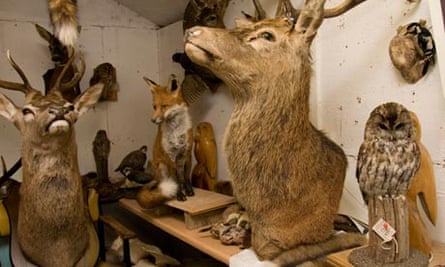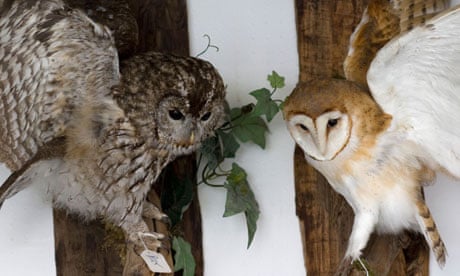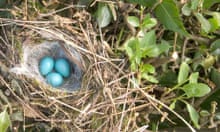Does there come a day in every man's life when he looks around and says to himself: I've got to weed out some of these owls? I can't be alone in this, can I? And, of course, you don't want to hurt anyone's feelings. Therefore you keep the crocheted owl given to you by your second-youngest sister and accidentally on purpose drop the mug that reads "Owl Love You Always" and was sent by someone who clearly never knew you to begin with. I mean, mugs with words on them! Owl cocktail napkins stay, because everyone needs napkins. Ditto owl candle. Owl trivet: take to the charity shop along with the spool-size Japanese owl that blinks his eyes and softly hoots when you plug him into your computer.
Just when you think you're making progress, you remember the owl tobacco tin and the owl tea cosy. Then there are the plates, the coasters, the Christmas ornaments. This is what happens when you tell people you like something. For my sister Amy, that thing was rabbits. When she was in her late 30s, she got one as a pet, and before it had chewed through its first phone cord she'd been given rabbit slippers, cushions, bowls, refrigerator magnets, you name it. "Really," she kept insisting, "the live one is enough." But nothing could stem the tide of crap.
Amy's invasion started with a live rabbit, while Hugh's and mine began, in the late 1990s, with decorative art. We were living in New York then, and he had his own painting business. One of his clients had bought a new apartment, and on the high, domed ceiling of her entryway she wanted a skyful of birds. Hugh began with warblers and meadowlarks. He sketched some cardinals and blue tits for colour and was just wondering if it wasn't too busy when she asked if he could add some owls. It made no sense nature-wise – owls and songbirds work different shifts, and even if they didn't they would still never be friends. No matter, though. This was her ceiling, and if she wanted turkey vultures – or, as was later decided, bats – that's what she would get. All Hugh needed was a reference, so he went to the Museum of Natural History and returned with Understanding Owls. The book came into our lives almost 15 years ago, and I've yet to go more than a month without mentioning it. "You know," I'll say. "There's something about nocturnal birds of prey that I just don't get. If only there was somewhere I could turn for answers."
"I wish I could help you," Hugh will say, adding, a second or two later: "Hold on a minute… what about… Understanding Owls?"

We've performed this little routine more times than I can count, but back then, when the book was still fresh-smelling and its pages had not yet yellowed, I decided that because Hugh actually did get a kick out of owls, I would try to find him a stuffed one. My search turned up plenty of ravens. I found pheasants and ducks, and foot-tall baby ostriches. I found a freeze-dried turkey's head attached to its own foot, but owls, no luck. That's when I learned that it's illegal to own them in the United States. Even if one dies naturally of a stroke or old age. If it chokes on a mouse or gets kicked by a horse. Should one fly against your house, break its neck and land like magic on your front stoop, you're still not allowed to stuff it or even to store its body in your freezer. Technically you're not even allowed to keep one of its feathers – that's how protected they are. I learned this at a now-defunct taxidermy shop in midtown Manhattan. "But if you're really interested," the clerk I spoke to said, "I've got a little something you might want to see." He stepped into the back room and returned with what I could only identify as a creature. "What we've done," he boasted, "is stretch a chicken over an owl form."
"That's really… something," I said, groping for a compliment. The truth was that even a child would have seen this for what it was. The beak made from what looked to be a bear claw, the feet with their worn-down, pedestrian talons: I mean, please! This was what a chicken might wear to a Halloween party if she had 10 minutes to throw a costume together. "Let me think about it," I said.
Years later we moved to Paris, where, within my first week, I found an albino peacock. I found swans and storks and all manner of seabirds but, again, no owls, because stuffing them is forbidden in France. In the UK, though, it's a slightly different story. You can't go out and shoot one, certainly. They're protected in life just as they are in the US, but afterwards, in death, things loosen up a bit. Most of the owls I saw in Britain had been stuffed during the Victorian era. I'd see them at English flea markets and in Scottish antique shops but, as is always the case, the moment you decide to buy one they're nowhere to be had. I needed one – or decided I did – in February 2008. Hugh and I were moving from our apartment to a house in Kensington and, after going through our owl objects and deciding we could do without nine-tenths of them, I thought I'd get him the real thing for Valentine's Day.
I should have started looking a month or two in advance, but with Christmas and packing and helping to ready our new place, it had slipped my mind. Thus I wound up on 13 February calling a London taxidermy shop and asking if they had any owls. The person who answered the phone told me he had two, both recent specimens, and freestanding, not behind glass as most of the old ones are. The store was open only by appointment, and after arranging to come by the following afternoon, I went to where Hugh was packing books in the next room and said: "I am giving you the best Valentine's Day gift ever."
This is one of those things I do and immediately hate myself for. How is the other person supposed to respond? What's the point? For the first 18 years we were together, I'd give Hugh chocolates for Valentine's Day, and he'd give me a carton of cigarettes. Both of us got exactly what we wanted, and it couldn't have been easier. Then I quit smoking and decided that in place of cigarettes I needed, say, an 18th-century scientific model of the human throat. It was life-size, about 4in long, and, because it was old, handmade, and designed to be taken apart for study, it cost quite a bit of money. "When did Valentine's Day turn into this?" Hugh asked when I told him that he had to buy it for me.
What could I say? Like everything else, holiday gifts escalate. The presents get better and better until one year you decide you don't need anything else and start making donations to animal shelters. Even if you hate dogs and cats, they're somehow always the ones who benefit. "Eventually we'll celebrate by spaying a few dozen kittens," I said, "but until that day comes, I want that throat."
On Valentine's Day, I carried a few boxes from our apartment to the house we'd bought. It looked like the sort of place where Scrooge might have lived – a narrow brick building, miserly in terms of space, and joined to identical, equally grim houses on either side of it. From there I walked around the corner and got on the underground. The taxidermy shop was on a quiet street in north London and, as I approached, I saw a man and his two sons with their faces pressed against the barred front windows. "A polar bear!" one of the boys shouted. The other tugged on his father's coat. "And a penguin! Look at the baby penguin!"
My heart raced.
The man who owned the shop was so much taller than me that, in order to look him in the eye, I had to throw my head all the way back, like I do at the dentist's. He had enviably thick hair and, as he opened the door to let me in, I noticed an orange kitten positioned on the floor beside a Dalmatian puppy. Casting a shadow upon them was a rabbit standing upright on its hind legs, and above him, on a shelf, sat two tawny owls, each mounted on a stump and standing around 20in high. Both were females, and in great shape, but what I'd really wanted was a barn owl. Those are the ones with spooky white faces, like satellite dishes with eyes.
"We do get those from time to time, but they're rare," the taxidermist said. Above his head hung a massive seagull with its beak open, and next to him, on a tabletop, lounged a pair of hedgehogs.
I've seen better variety, but there was no denying that the man did beautiful work. Nothing had crooked eyes or bits of exposed plaster at the corners of its mouth. If seen in a photo, you'd think that these animals were alive and had gathered peacefully to boast about their excellent health. The taxidermist and I discussed the owls, and when my eyes cut to a glass-doored cabinet with several weather-beaten skulls inside it, he asked if I was a doctor.
"Me?" For some reason I looked at my hands. "Oh, goodness no."
"Then your interest in those skulls is non-professional?"
"Exactly."
The taxidermist's eyes brightened, and he led me to a human skeleton half hidden in the back of the room. "Who do you think this was?" he asked.
Being a layman, all I had to go by was the height – between four and a half and five feet tall. "Is it an adolescent?"
The taxidermist invited me to guess again, but before I could he blurted: "It's a Pygmy!" He then told me that in the 19th century the English went to what is now the Congo and hunted these people, tracked them down and shot them for sport.
Funny how quickly this changed the mood. "But he could have died of a heart attack, right?" I said. "I mean, how are we to know for certain that he was murdered?"
"Oh, we know, all right," the taxidermist told me. It would have been disturbing to see the skeleton of a slain Pygmy in a museum, but finding him in a shop, for sale, raised certain questions, uncomfortable ones like: how much is he?
"If you like the odd bits and pieces, I think I've got something else you might enjoy." The taxidermist retreated to the area behind his desk and pulled a plastic bag off an overhead shelf. It was, I noticed, from Waitrose, a grocery store described to me upon my move to England as "a cut above". From the bag he removed what looked like a platter with an oblong glass dome over it. Inside was a man's forearm, complete with little hairs and a smudged tattoo. The taxidermist said, completely unnecessarily: "Now there's a story behind this." For what human limb in a Waitrose bag is not without some sort of story?
He placed the platter on the table, and as the lid was lifted and set to the side, I was told that, 100 years ago, the taxidermist's grandfather witnessed a bar fight between two sailors. One was armed with a sabre, and the other, apparently, was disarmed with one. After it happened, the crowd went wild. The amputee fell on his back, and as he lay there in shock, bleeding to death, the taxidermist's grandfather looked down at the floor, at the blood-soaked fingers that may have still been twitching, and likely thought: Well, it's not like it's doing him any good.
The story sounds a bit far-fetched, but there was no denying that the arm was real. The cut had been made two inches south of the elbow, and the exposed end, with its cleanly severed radius and ulna, reminded me of osso buco. "It was my grandfather who mummified it," the taxidermist said. "You can see it's not the best job in the world, but it's really rather good for a first attempt."
I leaned closer.
"Touch it," the taxidermist whispered.
As if I were under a spell, I did, shuddering a little at the feel of the hairs. Equally creepy was the arm's colour, which was not Caucasian flesh tone but not brown either, the way most desiccated body parts are. This was the same slightly toasted shade as a spray-on tan.
"I think I'll just take one of those owls," I said. "The one on the left, if that's OK."

The taxidermist nodded. Then he reached to an even higher shelf and brought down another plastic grocery bag, this one from Tesco, which is decidedly less upscale. "Now, a smell is going to hit you when I open this up, but don't worry," he said. "It's just the smoke they used to preserve the head."
That's a phrase you don't hear too often, so it took a moment for it to sink in. When he opened the bag, I saw that he might more accurately have said "the head of this teenage girl", for she'd been no older than 14 at the time of her death. This sounds super grisly but is, I propose, just medium grisly. The head was 400 years old and came from somewhere in South America – Peru, I think he said. The skin was dry and thin, like leather on an old worn-out purse. Parts of it were eaten away, exposing the skull beneath it, but what really struck me was her hair, which was sleek and black, divvied into delicate, slender braids.
I didn't ask the price but said a little more emphatically: "I really think the owl will do it for me today. It's a Valentine's Day present – perfect for our new place. A house, actually – no basement, and three storeys tall." I wasn't trying to be boastful. I just wanted him to know that I was loved, and that I lived above ground.
A few minutes LATER, the owl secured in a good-sized cardboard box, I headed back to the underground. Ordinarily I'd be elated – I'd been determined to find Hugh the perfect present, and, by golly, I had done it – but instead I felt unhinged, not by the things I had seen so much as by the taxidermist.
It's common to be misread by people who don't know you. "Like to try Belligerent, the new fragrance for men?" I'll be asked in a department store. And I always think: Really? Do I seem like the kind of guy who would wear cologne? Hotel operators so often address me as "Mrs Sedaris" that I no longer bother to correct them. I've been mistaken for a parent, a pickpocket, and even, God forbid, an SUV owner, and I've always been able to brush it off. What's rare is not to be misread.
The taxidermist knew me for less time than it took to wipe my feet on his mat, and, with no effort whatsoever, he looked into my soul and recognised me for the person I really am: the type who'd actually love a Pygmy and could easily get over the fact that he'd been murdered for sport, thinking breezily: Well, it was a long time ago. Worse still, I would flaunt it, hoping in the way a Porsche owner does that this would become a part of my identity. "They say he has a Pygmy," I could imagine my new neighbours whispering as I walked down the street. "Hangs him plain as day in the corner of his living room, next to the musket he was shot with."
I'd love to be talked about in this way, but how did the taxidermist know? Plenty of people must go into his store, ask for a kitten or a seagull or whatever, and walk out five minutes later knowing nothing about the human parts. Why show me the head in the grocery bag? As for the arm, how had he known I'd been dying to touch it? I hadn't said anything one way or the other, so what was the giveaway?
At the station I went through the turnstile and stood on the platform until a train arrived. The owl wasn't heavy – in fact it was surprisingly light – but the box was cumbersome, so I was happy to find a seat. At our first stop, a teenage girl in a school uniform got on and took the spot across from me. Deal with a kid her age today and the thought of her head winding up behind some shop counter in a plastic bag might not be all that troubling. I mean, the mouths on some of them! That said, it shouldn't be just any kid that age. The one the taxidermist showed me, for instance – what was her story? Fourteen-year-olds existed 400 years ago, but teenagers, with their angst and rebelliousness, their rage and Ritalin and very own version of Vogue magazine, are a fairly recent construct.
In the 17th-century jungles of Peru, a kid that age would have babies already. Half her life would probably be over, and that's if she was lucky. To have your chopped-off head preserved and then wind up in a Tesco bag some 6,000 miles away – that was the indignity. Tesco! At least the arm was in a Waitrose bag.
It bothered me that the bag bothered me more than the head did, but what are you going to do? A person doesn't consciously choose what he focuses on. Those things choose you, and once they do, nothing, it seems, can shake them. Find someone with a similar eye, and Christmas shopping is a breeze. I can always spot something for my sisters Gretchen and Amy. The three of us can walk into a crowded party and all zoom in on the person who's missing a finger, or who has one regular-size ear and one significantly smaller one, while my sister Lisa will pick up something else entirely.
Hugh and I don't notice the same things either. That's how he can be with me. Everything the taxidermist saw is invisible to him: my superficiality, my juvenile fascination with the abnormal, my willingness to accept and sometimes even celebrate evil – point this out, and he'll say: "David? My David? Oh no. He's not like that at all."
A person who's that out of it deserves both an owl and chocolate, so I got off the train at Piccadilly Circus and picked him up a box. Then I caught a bus and hurried toward home, thinking about love, and death, and about that throat, so elegant in its detail, which was, no doubt, awaiting me.
Extracted from Let's Explore Diabetes with Owls by David Sedaris, published by Abacus at £12.99 on 23 April. To order a copy for £10.39 with free UK p&p, go to guardian.co.uk/bookshop or call 0330 333 6846






Comments (…)
Sign in or create your Guardian account to join the discussion